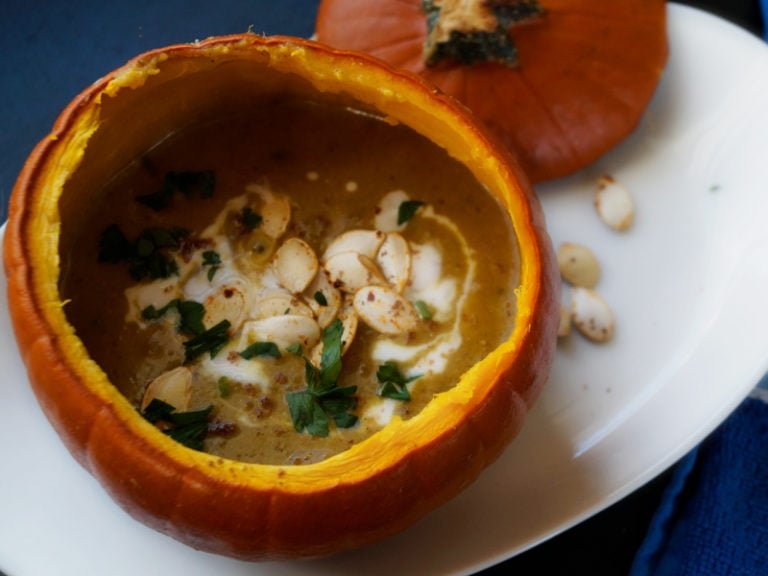Vegan Pumpkin Soup
You’ll need a cookie sheet, a food processor or immersion blender (OR a good hand-masher and some patience), a soup pot, and an oven for this soup. You’ll also need an adult to help with cutting, baking, and cooking on the stove top!
Ingredients
- 2 cups veggie stock
- 2 pie pumpkins (2lb or less each)
- 2 Tablespoons olive oil
- 2 Tablespoons curry powder (you can substitute half or all curry powder with Seven Spice powder – I do half and half)
- 1 bunch scallions
- 1 cup coconut milk + 2T for garnish
- Salt to taste
- Roasted pumpkin seeds
- Chopped parsley garnish optional
Preheat your oven to 350F.
Cut the tops off the pie pumpkins and scoop out the seeds and strings. Try not to scoop out solid flesh. Roast the pumpkins (top included) for 45 minutes. Remove and let cool, then carefully scoop soft meat out of pumpkin, taking care not to puncture the skin if you want to use the pumpkin as a bowl.
Add chopped scallions, spices, and olive oil to a saucepan or cooking pot and stir over medium heat until spices are fragrant, then add vegetable stock and ½ of the pumpkin flesh (all the flesh from one pumpkin).
Bring to a boil, then turn heat off. Allow to cool a little, then use immersion blender to puree. If you’re using a food processor, you need to let it cool down a lot before pureeing. You can also use a potato masher to squash all the squash, if you want your soup chunkier and more stew-like.
Add the rest of the pumpkin (cut into bite sized pieces), bring the soup to a boil again, turn down to simmer for 5 minutes, turn off heat, add coconut milk. Garnish with parsley, roasted pumpkin seeds, and a dollop of coconut milk.
To make the pumpkin seeds: Take all the pumpkin meat and gooey strings away until the seeds are mostly clean. Put them in a colander and run water over them, stirring them with your hands until all the pumpkin flesh is rinsed away. Pat them with a paper towel and spread them out on a cookie sheet to dry completely, then toss in a little olive oil (about 1 Tablespoon) and season with 1 teaspoon salt and your choice of other seasonings. I like to use spicy seasoning, like smoked paprika and Aleppo hot chili, but you can use whatever you like! Spread the seeds out again on the cookie sheet so they are in a single layer, and bake at 250F while you’re making the soup. Bake until seeds start to turn golden and are as crispy as you want them.
This recipe sounds like a lot of work, but it’s actually very easy. It’s a good teamwork exercise and looks fancy-pantsy for the holidays! If you’re not in a curry mood or don’t like spicy food, you could use nutmeg, sage, or other fragrant spices to season your soup.
While I was making this soup, I also cut my white fairtytale pumpkin (also called Ghost or Lumina) into slices and roasted it, too, so I can puree the roasted quash in a food processor and use it for my holiday breads and pies. Look at this beautiful pumpkin: white on the outside and pretty orange on the outside!

Squash is Awesome
Squash is used mostly by cooks as a vegetable because it goes well with savory spices – meaning, flavors that make up salty or spicy dishes, instead of sweet dishes. If you’ve ever had pumpkin pie or zucchini bread, you will know how sweet and tasty squash can be as a dessert, too! It is classified as a fruit because the seeds are inside. Vegetables are all the other parts of the plant, like stems, roots, and leaves.
classified as a fruit because the seeds are inside. Vegetables are all the other parts of the plant, like stems, roots, and leaves.
Squashes include winter and summer squash, and gourds. Did you know that all the parts of the squash plant are edible? That’s awesome! Tender shoots and leaves can be cooked into soups and stir fry dishes, as well as the blossoms (which are delicious battered and deep fried, or tossed in a little oil and seasoning and pan fried).
Summer squash types include zucchini, yellow (or summer) squash, and pattypan squash. These types of squash have a very thin skin and don’t last for more than a week or so after you’ve removed them from the vine.
Winter squash types include pumpkin, butternut squash, Delicata squash, and lots more. You can tell a winter squash from a summer squash because winter squash has a very thick, tough, inedible rind (or shell) on the outside. Decorative gourds fall into this group, though they are not always edible – some calabash varieties are poisonous in high concentrations (meaning, if you eat a large amount). While you can technically eat most of the decorative gourds you see in the grocery store, their flesh is very bitter, so we usually use them for fall decorations or crafts that involve allowing the middle of the gourd to dry out and using the hollow shell for anything from shakers (like a maraca), to birdhouses, to bowls and carrying baskets. With gourds and many other plants, that bitter taste is often nature’s way of saying, “you should avoid eating me.”
The word “squash” comes from the Massachuset (a tribe of people indigenous to North America) word askutasquash. Most squash originated in South and Central America, where it was then spread by human and animal migration to other continents, including North America. Calabash gourds, which are sometimes hollow, originated in Africa, and scientists believe they spread not only through migration, but also by hollow gourds full of seeds floating across the ocean. That is a long journey! If you look on a map and find East Africa, then find your house, how many miles would a gourd have to travel to get from its original home to you?
Summer squash grow all summer long and are plucked from their vines as they ripen through the whole summer. Winter squash also grow in the spring and summer seasons, but the biggest harvest comes in the fall. The reason they are called winter squash is because their rinds are so durable that, if they are not damaged or punctured, you can keep them all winter long! Squash become more bitter the longer they sit, though, so if you’re cooking with them you’ll want to do it soon after you buy or harvest them.

I used folded note cards to label the winter squash I have — but not just because I needed something to write on. If you’re cooking with winter squash and want to save seeds for your garden, you can label them, use tape to enclose the dried seeds in the paper, and store them in a cool (not freezing) place until you’re ready to plant them. If you have a patch of dirt or a nice big pot that isn’t occupied, try growing some of these yourself, and experiment with all the fun and tastiness squash has to offer!







 You’ll need a cookie sheet, a food processor or immersion blender (OR a good hand-masher and some patience), a soup pot, and an oven for this soup. You’ll also need an adult to help with cutting, baking, and cooking on the stove top!
You’ll need a cookie sheet, a food processor or immersion blender (OR a good hand-masher and some patience), a soup pot, and an oven for this soup. You’ll also need an adult to help with cutting, baking, and cooking on the stove top!

